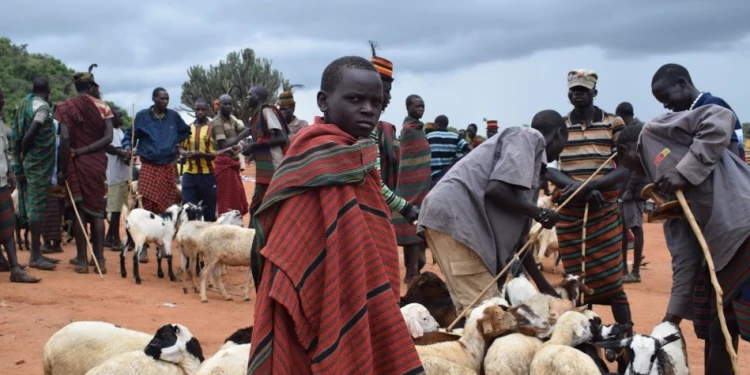By Andrew SK Kaggwa
A regional famine early warning network has warned of an impending food insecurity in Karamoja and northern Uganda due to insecurity related to livestock raids/thefts and the impacts of two consecutive below-average crop production seasons.
“In Karamoja, Stressed (IPC Phase 2) and Crisis (IPC Phase 3) outcomes are expected to remain widespread during the lean season through at least July, driven by below-average 2021 crop production, insecurity related to livestock raids/thefts, below-normal household income, and declining terms of trade. In bimodal areas, off-season rainfall in the central and western regions is supporting early field preparation activities for the first season. Given the above-average March-May rainfall forecast, near-average to above-average crop and livestock production is expected to support normal seasonal access to food and income, with Minimal (IPC Phase 1) outcomes expected through September. However, in the greater northern Uganda, Stressed (IPC Phase 2) outcomes are now expected to persist through June given the impacts of two consecutive below-average crop production seasons,” says a report on food security in Uganda for the coming months released on March 1stby the Famine Early Warning Systems Network (FEWS NET).
The report further says that the below-average rainfall received during the October-December 2021 second rainy season, production of cereals and perennial crops – such as bananas, cassava, sweet potatoes, and Irish potatoes – in the 2021 second season harvest ranged from near average to below five-year average levels, with the greater northern Uganda registering the most significant deficits.
“Overall, the national surplus of food is less than usual,” says FEWS NET.
The Famine Early Warning Systems Network is a leading provider of early warning and analysis on food insecurity. Created by USAID in 1985 to help decision-makers plan for humanitarian crises, FEWS NET provides evidence-based analysis on approximately 30 countries.
Deterioration of pasture
“Since the start of the year, light to moderate rainfall has been received during the dry season, with cumulative rainfall above average in much of the southern half of the country and with near normal drier conditions in the north. However, spatial and temporal distribution of rainfall has been uneven. Northern Uganda received unevenly distributed light rains in mid-January, while Central and Western Uganda received light to moderate rains in February. From late 2021 to late January 2022, land surface temperatures were generally above average by up to 7 degrees Celsius in widespread northern and eastern areas, with Teso, Karamoja, and Lango experiencing the hottest temperatures. As a result, drier than usual conditions lead to atypically early deterioration of pasture and water resources and below-average conditions through mid-January 2022. However, in February temperatures have been below average. According to the Normalized Difference Vegetation Index (NDVI) derived from satellite data, vegetation conditions are now near seasonally low levels in mid-February. Livestock body conditions have been slightly below average in areas of the cattle corridor where rangeland resources have been below average, mostly in the central and greater northern Uganda. In the cattle corridor districts that experienced water shortages, like Nakasongola and parts of Kiboga, Nakaseke, Luwero, and Ntoroko, productivity of meat and milk output has been less than usual,” reads the report.
Still on pastoralism, FEWSNET says: In February, an outbreak of Foot and Mouth Disease (FMD) led to a livestock quarantine (prohibiting livestock movement) and the closure of livestock markets in Rakai and Kyotera districts. FMD is endemic to these areas of the cattle corridor, and outbreaks are frequent. As a result, households lose income due to inability to sell their livestock, impacting household livelihoods and wellbeing. Reasons for the recurring outbreaks include low livestock vaccination rates caused by low supplies of genuine veterinary drugs, movement of cattle across the Tanzanian border, and sharing of grazing areas in the national park.
Fuel prices inflation
On the Covid-19 pandemic the report is optimistic of the full recovery of the economy.
“Since January, restrictions on most sectors of economic activity have been fully lifted. This follows a significant decrease in COVID-19 incidence and improved coverage of vaccination against the virus. According to the Bank of Uganda monetary policy statement for February 2022, the high-frequency indicators (indices) of economic activity between October 2021 and January 2022 suggest a strong economic rebound in both domestic and external demand relative to the previous period. Alongside this recovery, there has been a marked increase in the availability of income-generating activities that is supporting households’ access to income and facilitating their ability to purchase both food and non-food items for their normal living,” says FEWSNET.
The report however says the increase in fuel prices have led to spike in the prices of essential commodities.
“High fuel prices since December have resulted in an increase in the prices of some basic food and non-food items such as sugar, cooking oil, wheat flour, and soap, which are limiting improvements in purchasing power. High fuel prices are also expected to be straining those livelihood activities dependent on fuel, such as in the transportation sector,” the report says.
On markets and trade the report says: In the fourth quarter of 2021, export levels of maize and beans remained below the five-year average, while exports of sorghum were above average. Maize and sorghum exports to South Sudan were above average following measures taken by the South Sudanese government in 2020/2021 which have improved availability of hard currency and the stability of the exchange rate, facilitating imports. However, maize exports to Kenya fell precipitously, reducing fourth quarter regional maize trade compared to average levels due to increasing competitiveness of Tanzanian maize in Kenya. Uganda’s sorghum exports accounted for 94 percent of the region’s total sorghum trade, with increased exports driven by significant demand from South Sudan. Ugandan bean exports accounted for 95 percent of the region’s total exports, with South Sudan and Kenya importing 83 percent and 17 percent, respectively, of Uganda’s total bean exports. Overall, however, there was a reduction in regional trade of beans due to below-average rainfall and production levels in the region.
Optimistic of future
Looking ahead, FEWSNET is optimistic of increased food production to the predicted above average rainfall in the March to May (MAM) rainfall season.
“Given the forecast for above-average rainfall, first season crop production levels (of cereals and legumes, as well as typical perennial crops such as tea, coffee, sugarcane, and bananas) are expected to be average to above average (though this depends on the timing and distribution of rainfall) and restore typical household and market food stock levels in June/July. Green harvest consumption is expected in May/June, starting in the south. Market supplies and household food stocks in bimodal areas are likely to be near typical levels from June to September,” says the report.
Do you want to share a story, comment or opinion regarding this story or others, Email us at newsdayuganda@gmail.com Tel/WhatsApp........0726054858



